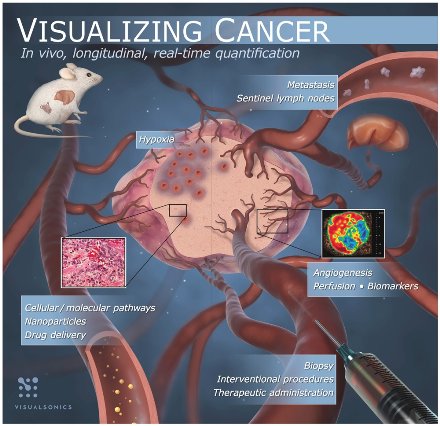Photoacoustic system images structural, molecular and functional properties of tumours simultaneously
4 April 2011
VisualSonics, a subsidiary of SonoSite, has launched the Vevo LAZR Photoacoustics Imaging system that enables pre-clinical researchers to visualize structural, molecular and functional attributes of tumors simultaneously.
The new system has been designed for use in pre-clinical research and could herald major breakthroughs in cancer research; however, human applications of the technology are envisioned in the near future.
This innovative technology works by combining the sensitivity of optical imaging with the resolution and depth penetration of high-frequency ultrasound — pioneered by VisualSonics — enabling researchers to study cancer in its earliest stages of progression and evaluate tumor growth.
For the first time, researchers will be able to observe tumor biology, measure hypoxia (oxygen levels), evaluate changes in blood flow, and quantify data with unique software solutions in vivo and in ‘real time’. Consequently, this technology provides researchers with never-before-seen insights into the development of effective therapeutics for treating cancer.
“The Vevo LAZR is a crucial breakthrough, with wide ranging implications for cancer research. In recent years the fight against cancer has centered on stopping growth using drugs (anti-angiogenesis therapeutics, for instance). If angiogenesis can be stopped or prevented from occurring, tumor growth can be controlled and significantly reduce harm to their hosts,” added Dr Emelianov.
The ability to see the effect that a drug is having on the tumor growth is an invaluable asset in the development of cancer therapeutics. In practical terms, this means researchers will be able to observe tumor biology in a living host organism (mice and rats) without having to biopsy the actual tumour itself.
Currently, researchers are often required to rely on ex vivo techniques such as histology and immunohistochemistry to obtain molecular information inside a tumour. The in vivo approach reduces the amount of animals required for research studies by allowing the same animal to be followed throughout the disease development and treatment.
The Vevo LAZR uses a laser to shoot pulses of light through the skin into tissue and cells beneath the surface. The absorbed laser energy is then converted into heat, producing an ultrasonic emission, which can be captured and turned into images using a specially adapted high frequency ultrasonic probe.
The key to this novel approach is the wide range of biological materials that absorb the laser energy. Specific tissue components including oxyhemoglobin, deoxyhemoglobin, melanin, and lipids all absorb light, meaning it’s now possible to see even tiny structures like nuclei from inside a living cell.

The range of photoacoustic applications
Dr Emelianov continued, “Being able to look at molecular level cell physiology, and to do so in a living organism, will greatly facilitate our understanding of how cancer spreads from the micro to the macro level, giving unparalleled insights into how tumors grow and metastasize within human tissue.”
Introducing an efficient way to screen and reject unpromising compounds during the discovery research phase of development, such as in vivo preclinical imaging, could save some of the large amount of money required to produce them.
One of the first scientific users of the Vevo LAZR system, David A. Jaffray, Ph.D, Head, Radiation Physics, Ontario Cancer Institute / Princess Margaret Hospital added: "Advanced imaging technologies like VisualSonics' Vevo LAZR photoacoustics system allow our scientists to see into the processes that sustain a disease like cancer. With this knowledge, we can design the next generation of therapies."
VisualSonics’ President and CEO, Anil Amlani, said: “The Vevo LAZR photoacoustics system is a breakthrough in-vivo imaging technology. Advancements featured in this product will enable oncology researchers to accelerate their research into understanding of the inner workings of the cancerous cell and the host tissue in which it resides. The ability to conduct this microscopic level research in a living organism, non-invasively and in real-time will help our customers to turn groundbreaking science into lifesaving care, at an even greater speed”.
The platform of the Vevo LAZR system integrates proprietary imaging capabilities that will further improve a researcher’s overall experience and will set new standards for performance in pre-clinical research. The system’s co-registration function is an essential feature that will aid in the discovery and assessment of novel drug therapies.
With the ability to capture high-resolution images with high-frequency ultrasound, the co-registration function enables researchers to simultaneously superimpose a photoacoustic signal over the ultrasound image, allowing for the assessment and quantification of oxygen saturation and blood levels in tissues and organs.
The Vevo LAZR system also includes an automated multispectral imaging algorithm that provides researchers with the flexibility of selecting multiple imaging wavelengths to optimize the visualization of contrast agents, such as nanoparticles and dyes.
SonoSite President and CEO, Kevin M. Goodwin, added: “We believe that the Vevo LAZR system will have a strong impact on the discovery of new cancer therapies, more efficient testing of therapies with never-before-seen seen insights into cancer and quantified measures of cancer progression, viewed from inside the tumor. With the launch of Vevo LAZR technology, we continue to meet our commitment to our customers by providing imaging technologies needed to further tomorrow’s research today ”